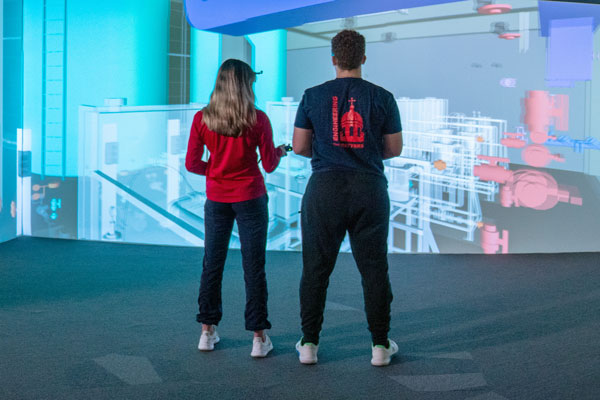News

Virtual reality lab brings buildings to life for civil engineers
When a building is built, it's too late to change the placement of something. But a new virtual reality lab for civil engineers at the University of Dayton will bring buildings to life before dirt is turned, allowing engineers to see if the way it's intended to be built is the way it should be.
The Greg and Annie Stevens Intelligent Infrastructure Engineering Lab, dedicated Aug. 19, allows students to get a feel for a structure before construction. Users load blueprints or any other computer-aided design drawings, or sensor data into the system, which then goes beyond photo mockups by creating a virtual facility in which users can float up, down, side-to-side, through walls, onto the roof or into the basement similar to 360-degree theaters, complete with that weird feeling in your stomach.
"I hope this gift helps elevate the technological edge of the UD School of Engineering. This new modeling simulator and innovation space will provide a unique high tech tool to learn the new methods of designing for the future," said Greg Stevens, who earned a B.S. in civil engineering from UD in 1993. "Building in detail in a virtual environment is critical to meeting the budget and timing constraints of large projects.
"And giving this skill to UD engineering students before they leave the classroom will provide them with highly valuable experience as they transition to the workforce."
Lab capabilities even allow students to test how environmental conditions will affect a structure.
"In the real world, it's difficult to fly around an object other than using a drone, but in a virtual environment, once data are collected, we can inspect any structure, inside or outside, and zoom in and out at our wish," said Hui "Jack" Wang, University of Dayton assistant professor for civil and environmental engineering and engineering mechanics.
According to civil and environmental engineering and engineering mechanics department chair Robert Liang, the lab can also be used for ”change detection,” or what a building was versus what a building is now, as in the situation of a building collapse.
"If we have a baseline model before and after an earthquake, we can examine the damage more accurately," Wang said. It also will allow for a safer examination for inspectors who won't have to enter a dangerous building or stand on top of an unstable pile of rubble while rescuers are working.
The lab, in the School of Engineering's Kettering Labs, is not just for civil engineers. UD researchers in artificial intelligence will help refine techniques to help automate detection of building defects. Experts in human factors and psychology will examine how people interact with the building to see if the building is "user friendly."
"Civil engineers design things for humans, but usually we don't think about how humans react to our designs. Now we can bring people into the virtual environment to see how they respond when they see the space — are they happy, mad or indifferent — even before it's built. It can help us optimize our construction design to make a building more comfortable," Liang said. "It's more efficient and cost effective to determine up front whether this building won't work for the stakeholders and end users."
UD students already are utilizing the lab, immersing themselves in the University's Roger Glass Center for the Performing Arts under construction now. Arts center contractor Messer Construction is using it as well. Liang said he hopes to open the lab capabilities to industry partners.
When those industry partners are in the room reviewing their plans, students will be in the room as well to see "how real-life engineers discuss a real project, and their thought process," Liang said.
"For teaching, we have a lot of tools."
For interviews, contact Shawn Robinson, associate director of news and communications, at srobinson1@udayton.edu.
